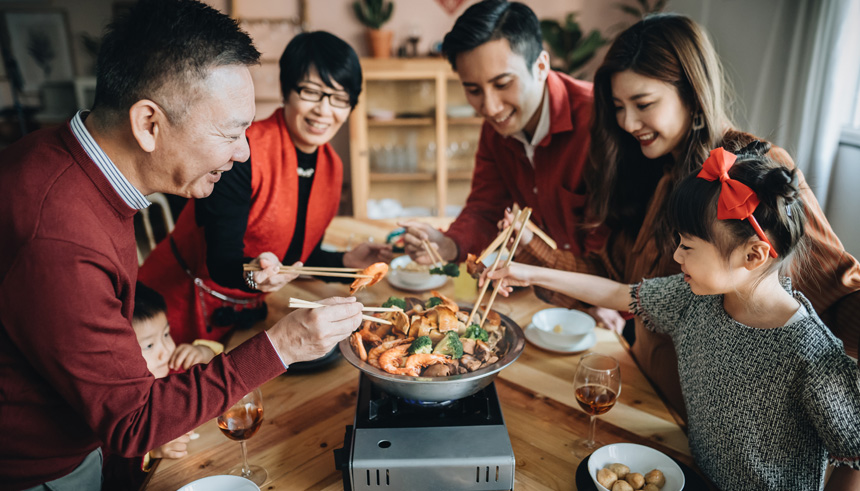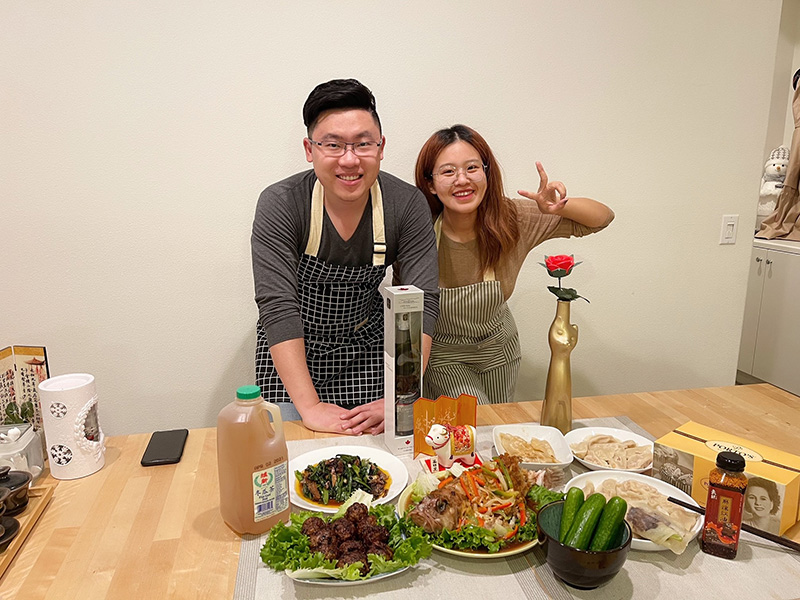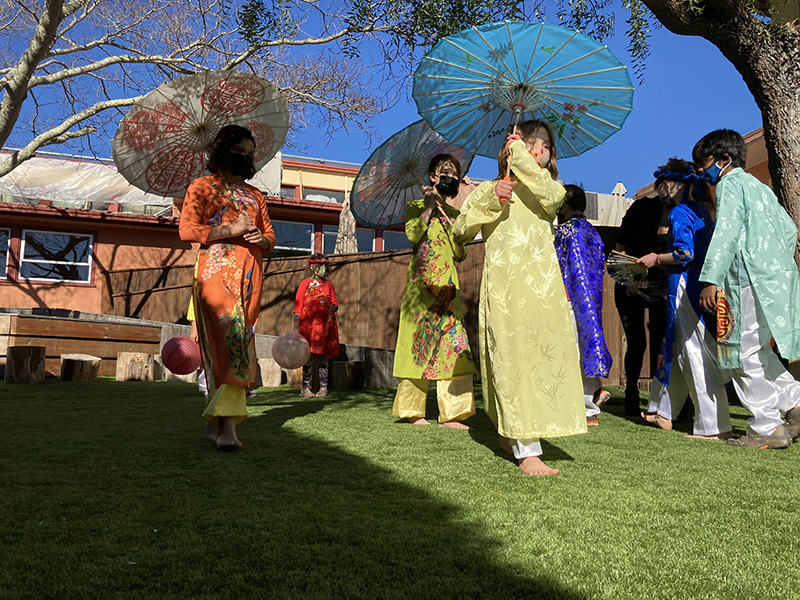East West Lifestyle
A Look at Some Lunar New Year Traditions
By

Some East West Bank clients share their traditions, old and new, for Lunar New Year.
An estimated 2 billion people celebrate Lunar New Year around the world, spanning several countries and numerous cultures. For many, Lunar New Year celebrations last for a whole week. Although some of the traditions may differ geographically, there are certain things that remain the same: family, food, and firecrackers to ward off evil spirits.
This year, Lunar New Year falls on February 1. In the spirit of building cultural bridges, we asked some of our East West Bank clients what some of their favorite Lunar New Year traditions—and foods—are, and how they’re planning on celebrating this year.
Thuy Nguyen – Advantek Ceramics Corp.
In Vietnam, the Lunar New Year celebration is called Tet Nguyen Dan (commonly referred to as just Tet), which is also known as the Spring Festival.
For Thuy Nguyen and her family, their Tet celebrations start with going to one of the festival celebrations in the Bay Area, where there is an abundance of New Year foods, such as banh tet (one of Nguyen’s favorite Lunar New Year foods), as well as festive firecrackers. Nguyen adds that typically they dress in ao dai, which are traditional Vietnamese tunics, for Lunar New Year festivities.
As a symbol of fresh beginnings, Nguyen says that it’s Vietnamese tradition to wear new clothes for the new year. “You’re wearing old clothes for the whole year, but for the New Year, you have to wear beautiful, new clothes,” she shares. “We love when Vietnamese New Year comes.”
Nguyen and her family also go to the Buddhist temple to pray as part of their New Year festivities. “We go to pray for good luck for the whole year, for good luck in work, family, and health,” she says.
To reinforce that good luck, Nguyen and her family eat vegetarian for the whole day. “We don’t eat meat or seafood or anything, only vegetables, in order to keep the body pure,” she says.
Nguyen adds that her kids love New Year because part of the tradition is for older family members to pass out red envelopes filled with money to the younger generations. However, Tet holds some bittersweetness for her.
“My kids love it because of the clothes and red envelopes—but it just reminds me that I’m getting older,” she laughs.
Eric Zhang – Boiling Point
Dumplings are a popular food to eat for Lunar New Year in China because, as tradition goes, the more dumplings you eat during the celebrations, the more money you will make in the new year. However, for Eric Zhang, his favorite thing is making the dumplings.
“The importance of making dumplings is the teamwork, and also increasing the bonding of the family members,” he explains. “This is not a one person job—it involves intensive labor and the family needs to gather together to do the work and enjoy the meal. So this is one of my favorite parts.”

Back in Zhang’s hometown of Tianjin in Northern China, they put coins in dumplings for people to find, almost similar to an Easter egg hunt.
“The coin means fortune, so they can bring a fortune to the whole family,” Zhang explains. “It’s like a challenge for people, like guessing who is the lucky guy who will get the dumpling with the coin?”
In addition to dumplings, another one of Zhang’s favorite Lunar New Year foods is roasted duck. Poultry symbolizes loyalty in Chinese culture, and Peking duck is one of the most popular dishes to eat during the celebrations.
In China, Lunar New Year celebrations usually go on for at least seven days and have a particular emphasis on family gatherings and relationships. “On New Year’s Eve, family members gather together, eat dumplings, that sort of thing,” Zhang shares. “Then on New Year’s day, you visit your significant other’s family, the second day is elder family members and friends living out of town, etc. There’s a sequence—you have to visit the ‘VIPs’ first.”
This year, Zhang plans on spending a quiet night making dumplings with his significant other, due to ongoing concerns over the pandemic.
“My biggest wish is hoping restaurant business will prosper again. I really, really hope all the frontline workers, including doctors, nurses, restaurant staff, police officers, everybody, is healthy,” Zhang says. “I’m just really grateful for the sacrifices.”
Wendy Xa – Terra Marin School
For Wendy Xa, Lunar New Year is not only a time to connect with family, but an opportunity to share these cultures and traditions with a wider audience. Although Xa lives in and operates a school in the Bay Area of California, she came to realize that just because the region had a large Asian population, that didn’t mean that everyone had the same exposure to different cultures. They decided to put together a Lunar New Year event highlighting the traditions of China, South Korea, and Vietnam.

“Seventy percent of our school’s population is non-Asian,” says Xa. “We're in community that is not very much Asian at all, and this is our way of sharing something joyful and exciting to a community that may not know what we celebrate.”
“Seventy percent of our school’s population is non-Asian,” says Xa. “We're in community that is not very much Asian at all, and this is our way of sharing something joyful and exciting to a community that may not know what we celebrate.”
On a personal level, Lunar New Year has really brought to focus the familial aspect of the holiday for Xa. “I think families like us who have children or a loved one at home are really lucky,” says Xa. “In about five years, both my children will have gone to college, but now I get to really be with them. So I'm just very grateful that I have a healthy family.”
Chris Light – TS Emporium
In Mandarin, the word for fish (yu) is a homonym for the word abundance, so fish and seafood are often popular foods to eat during Lunar New Year.
One of Chris Light’s favorite dishes to eat was Cantonese seafood stew, which includes an abundance of different types of seafood delicacies such as sea cucumber, fish maw, and abalone.
“Growing up in Taiwan, we always had one dish that nobody's supposed to touch for until days after Chinese New Year,” says Light. “There's a phrase called nian nian you yu, meaning every year you have leftovers or are overflowing, excess. Every year, we would have one huge steamed fish, and we would just leave it there for days to just give that feeling that we have a lot of extra left over from the previous year to this year.”
Another tradition is handing out red envelopes filled with money to children. “One huge thing is greeting the ‘elderly,’” Light shares. “The aunts and uncles would come over to our house, or we would walk over to their house. Every time you visit their house, that was a sure way of receiving a red envelope, so you wanted to visit as many as possible.”
A newer tradition that Light adopted was gathering with friends after New Year’s dinner to play a game of Hoo Hey How (translated as Fish Crab Prawn), which is a traditional Chinese dice game.
“It's a simple little game that you can bet on—it's almost like roulette really,” Light explains. “It’s a very interesting game that you usually only play during Chinese New Year for good luck.”
Subscribe to the Reach Further Newsletter
Get inspiring stories in your inbox every month.

